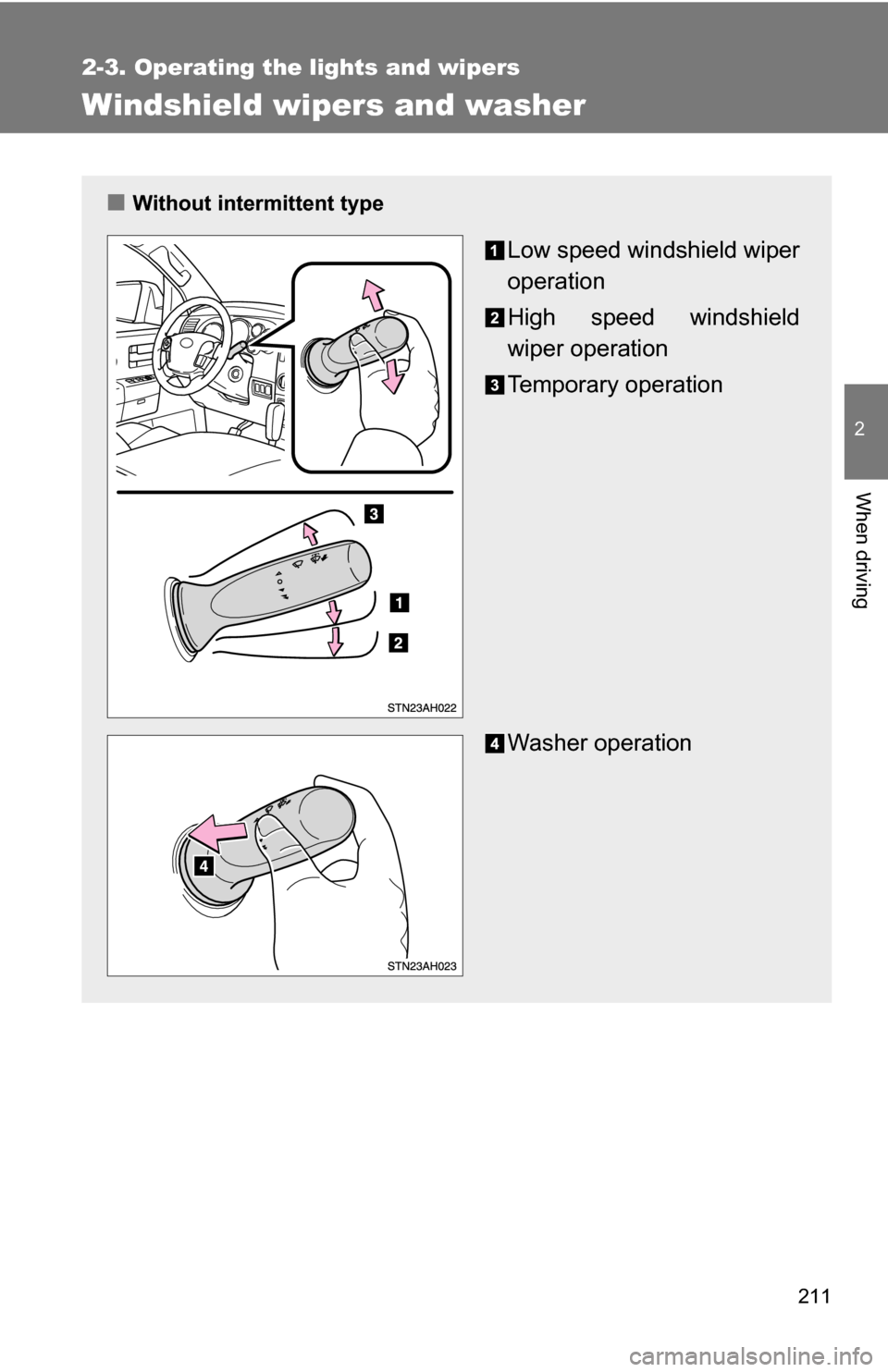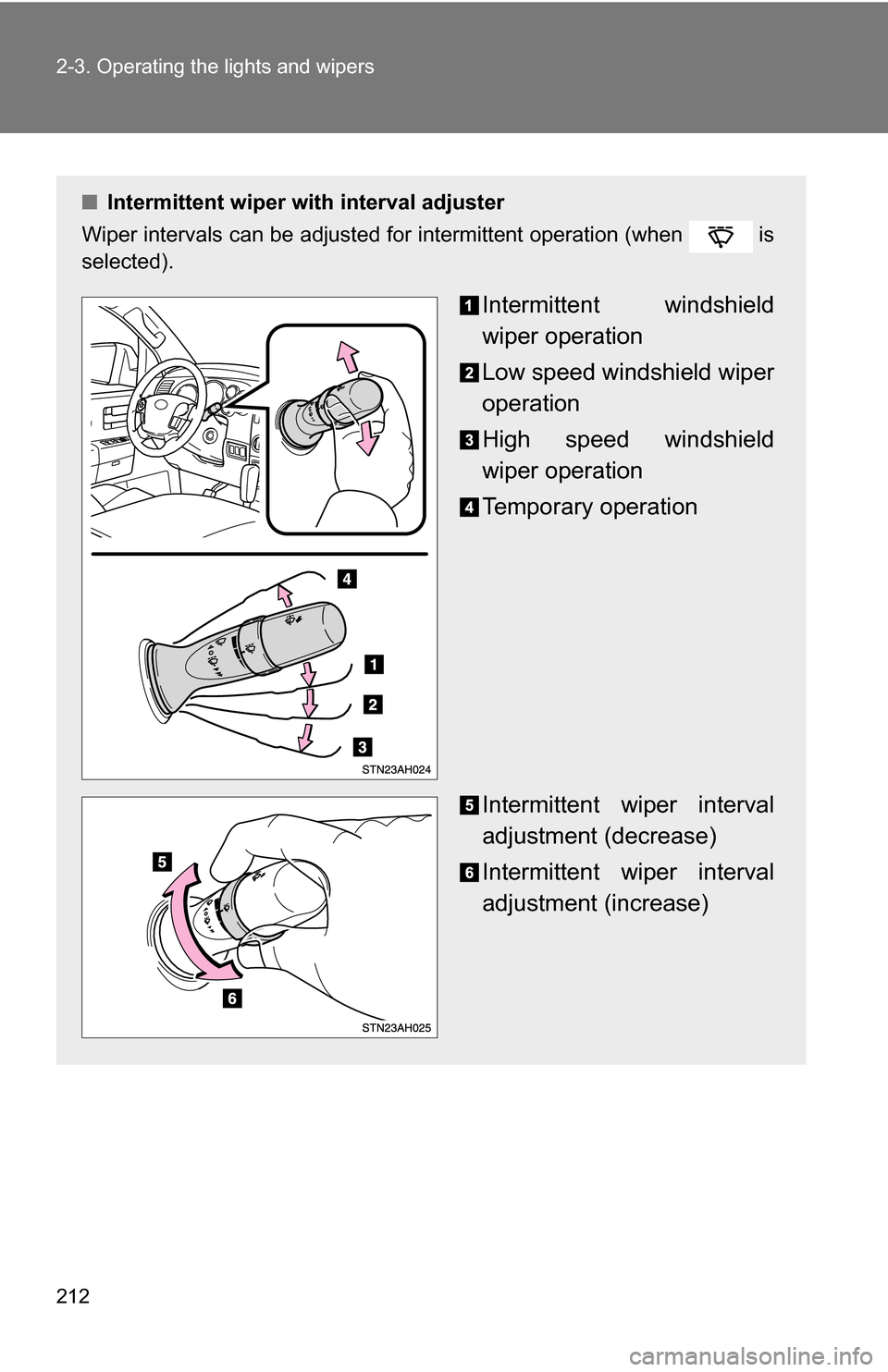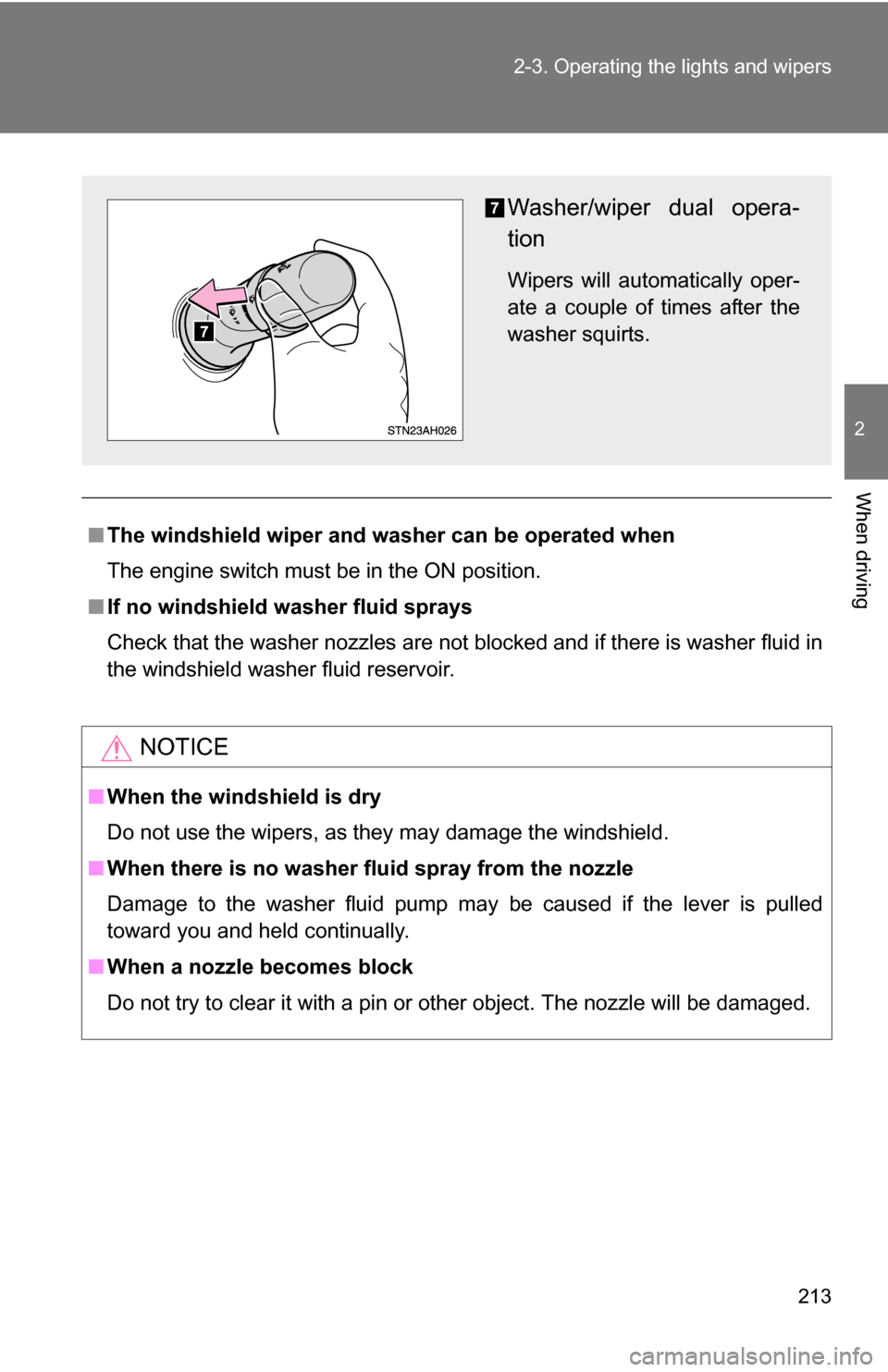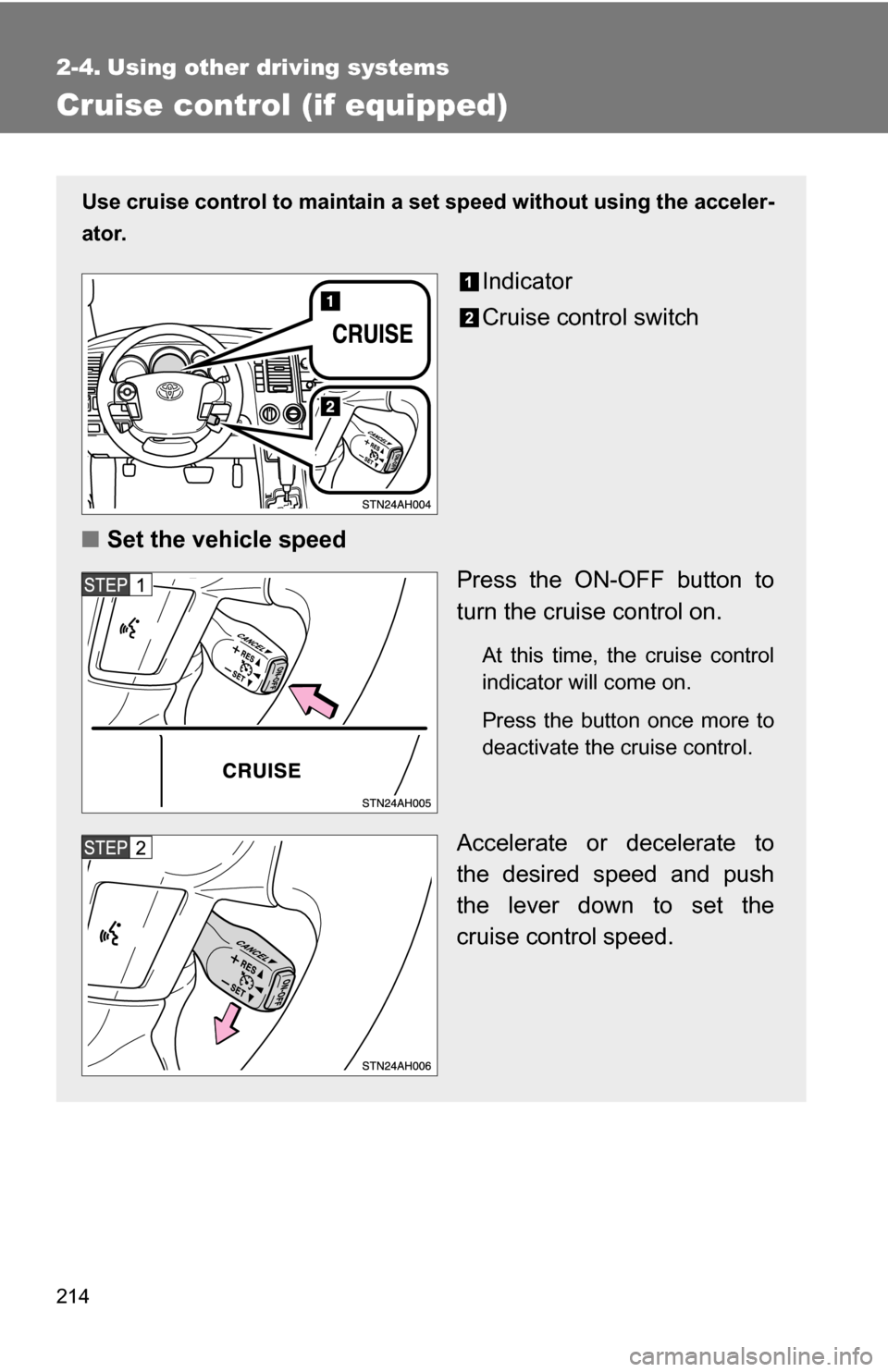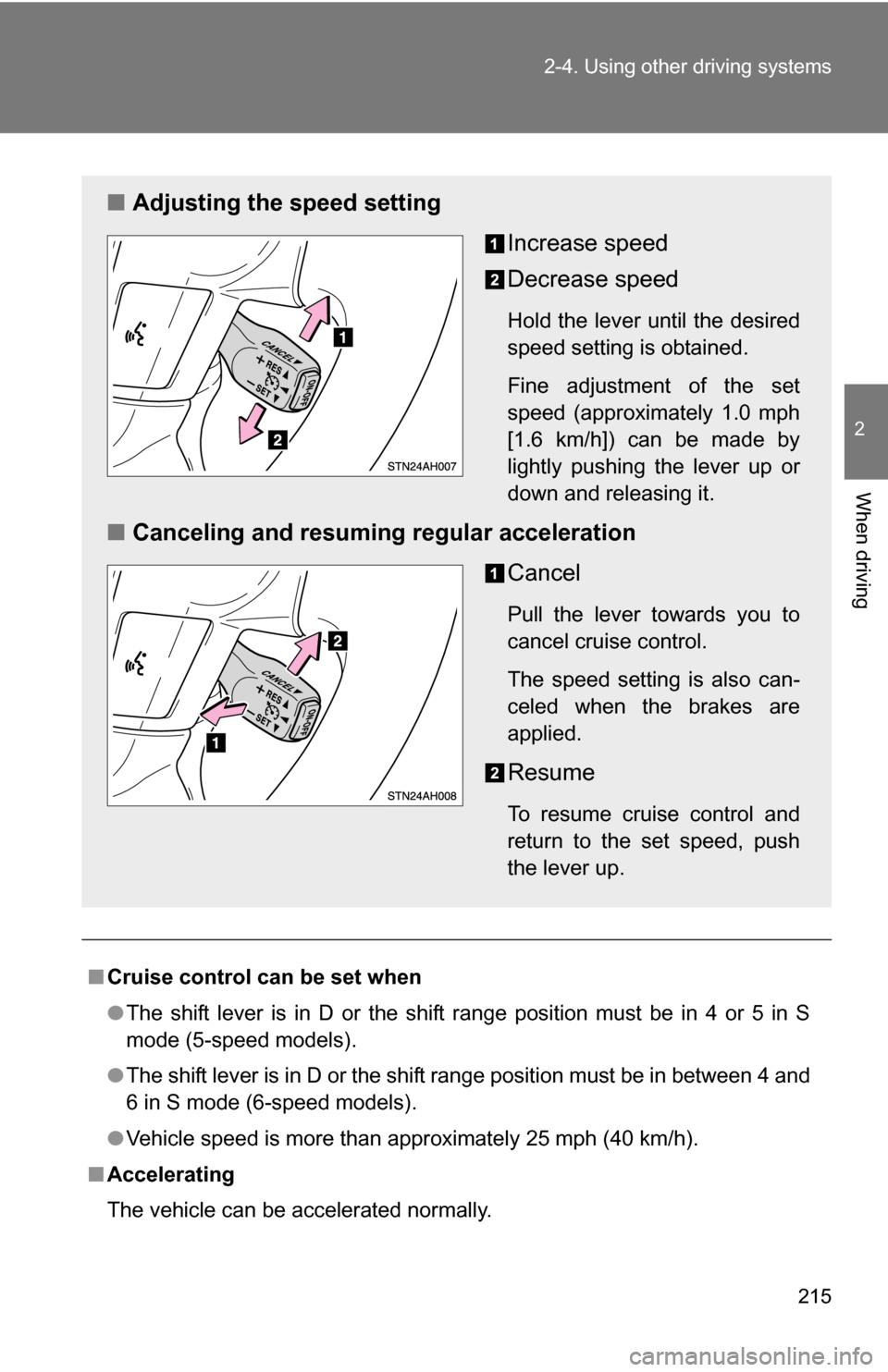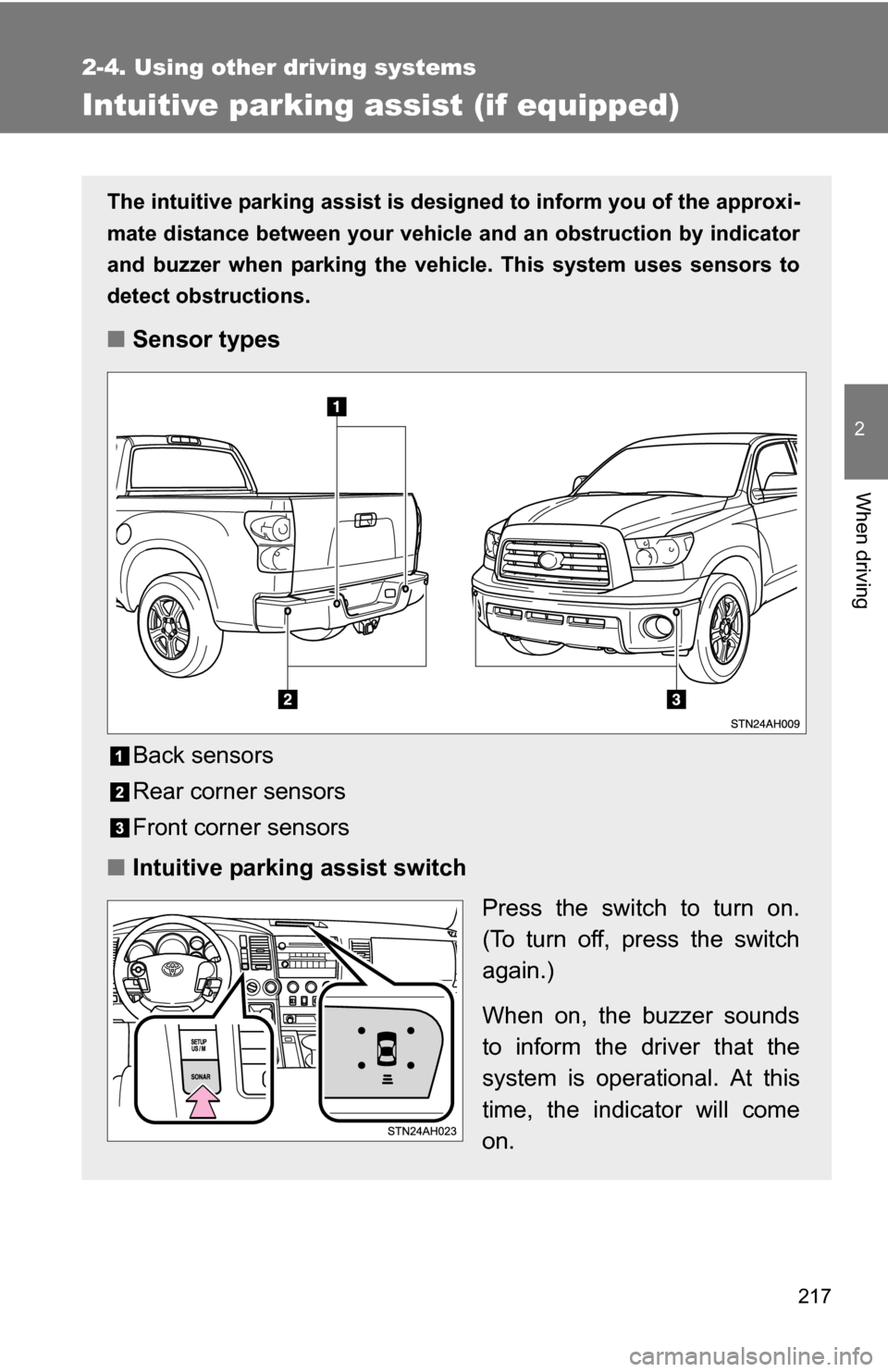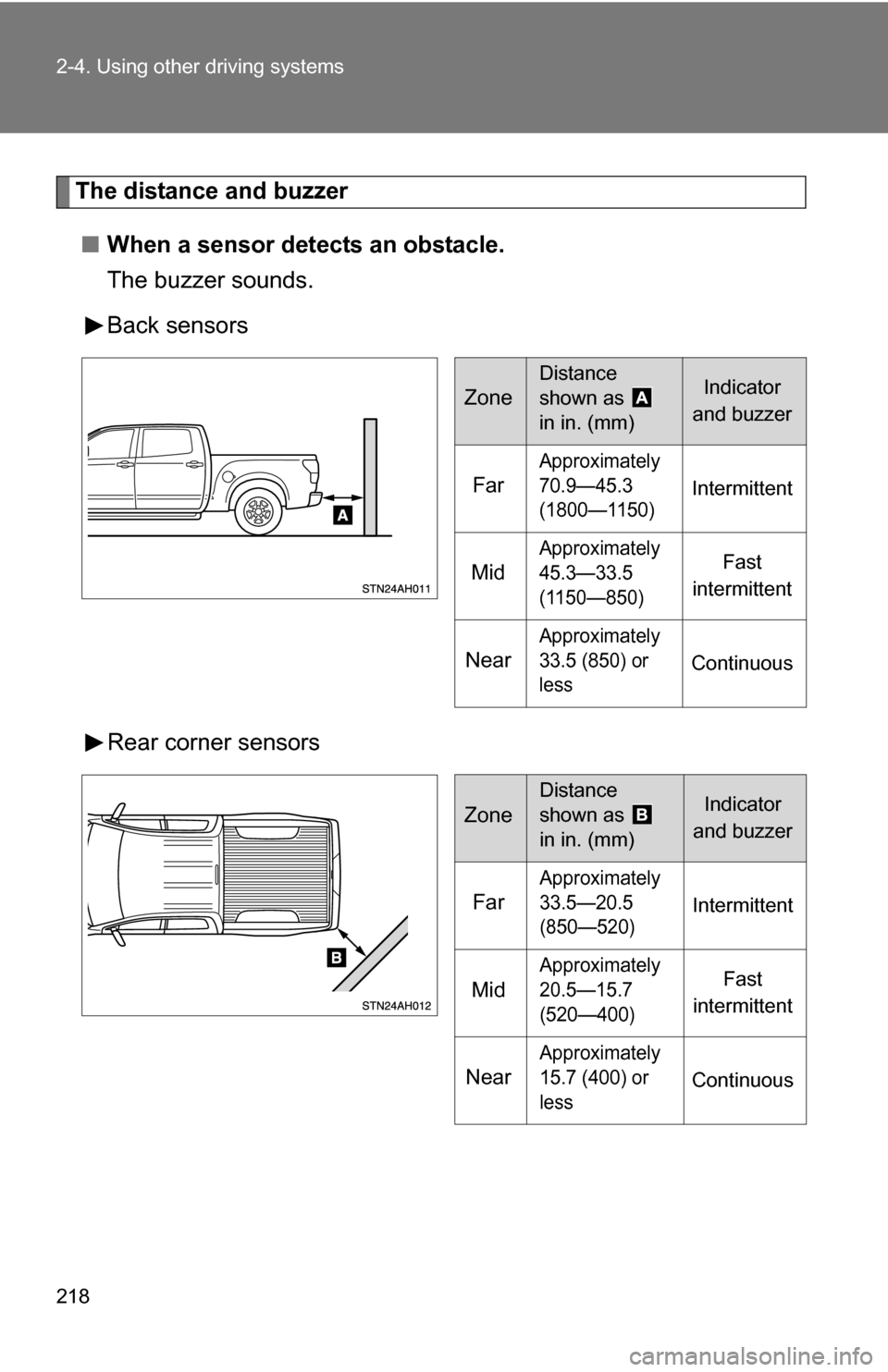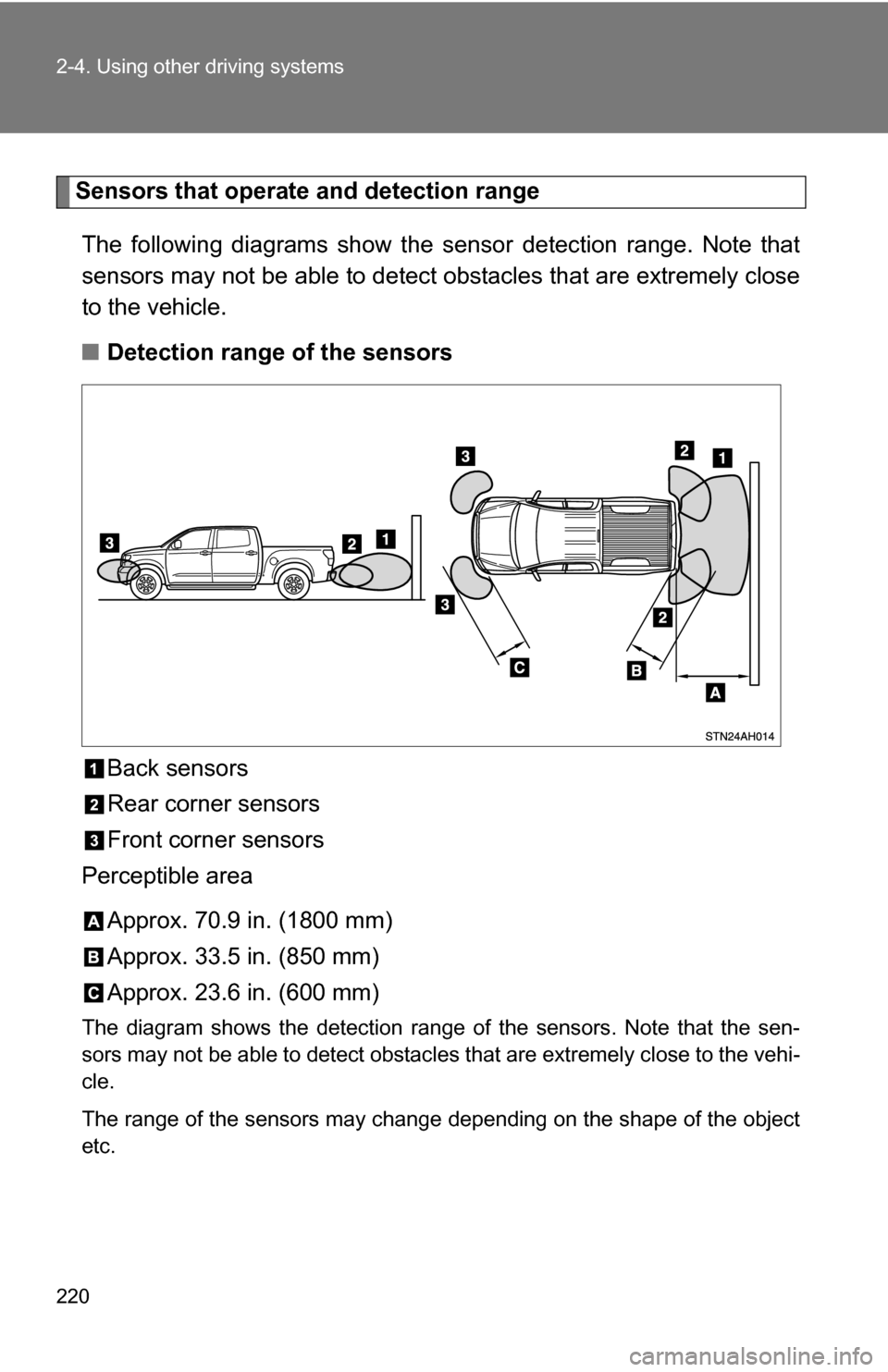TOYOTA TUNDRA 2009 2.G Owners Manual
TUNDRA 2009 2.G
TOYOTA
TOYOTA
https://www.carmanualsonline.info/img/14/6829/w960_6829-0.png
TOYOTA TUNDRA 2009 2.G Owners Manual
Trending: airbag, octane, brake rotor, child seat, load capacity, check engine, seats
Page 211 of 672
211
2-3. Operating the lights and wipers
2
When driving
Windshield wipers and washer
■Without intermittent type
Low speed windshield wiper
operation
High speed windshield
wiper operation
Temporary operation
Washer operation
Page 212 of 672
212 2-3. Operating the lights and wipers
■Intermittent wiper with interval adjuster
Wiper intervals can be adjusted for intermittent operation (when is
selected).
Intermittent windshield
wiper operation
Low speed windshield wiper
operation
High speed windshield
wiper operation
Temporary operation
Intermittent wiper interval
adjustment (decrease)
Intermittent wiper interval
adjustment (increase)
Page 213 of 672
213
2-3. Operating the lights and wipers
2
When driving
■
The windshield wiper and washer can be operated when
The engine switch must be in the ON position.
■ If no windshield washer fluid sprays
Check that the washer nozzles are not blocked and if there is washer fluid in
the windshield washer fluid reservoir.
NOTICE
■When the windshield is dry
Do not use the wipers, as they may damage the windshield.
■ When there is no washer fluid spray from the nozzle
Damage to the washer fluid pump may be caused if the lever is pulled
toward you and held continually.
■ When a nozzle becomes block
Do not try to clear it with a pin or other object. The nozzle will be damaged.
Washer/wiper dual opera-
tion
Wipers will automatically oper-
ate a couple of times after the
washer squirts.
Page 214 of 672
214
2-4. Using other driving systems
Cruise control (if equipped)
Use cruise control to maintain a set speed without using the acceler-
ator.
Indicator
Cruise control switch
■ Set the vehicle speed
Press the ON-OFF button to
turn the cruise control on.
At this time, the cruise control
indicator will come on.
Press the button once more to
deactivate the cruise control.
Accelerate or decelerate to
the desired speed and push
the lever down to set the
cruise control speed.
Page 215 of 672
215
2-4. Using other
driving systems
2
When driving
■Cruise control can be set when
●The shift lever is in D or the shift range position must be in 4 or 5 in S
mode (5-speed models).
● The shift lever is in D or the shift range position must be in between 4 and
6 in S mode (6-speed models).
● Vehicle speed is more than approximately 25 mph (40 km/h).
■ Accelerating
The vehicle can be accelerated normally.
■ Adjusting the speed setting
Increase speed
Decrease speed
Hold the lever until the desired
speed setting is obtained.
Fine adjustment of the set
speed (approximately 1.0 mph
[1.6 km/h]) can be made by
lightly pushing the lever up or
down and releasing it.
■Canceling and resuming regular acceleration
Cancel
Pull the lever towards you to
cancel cruise control.
The speed setting is also can-
celed when the brakes are
applied.
Resume
To resume cruise control and
return to the set speed, push
the lever up.
Page 216 of 672
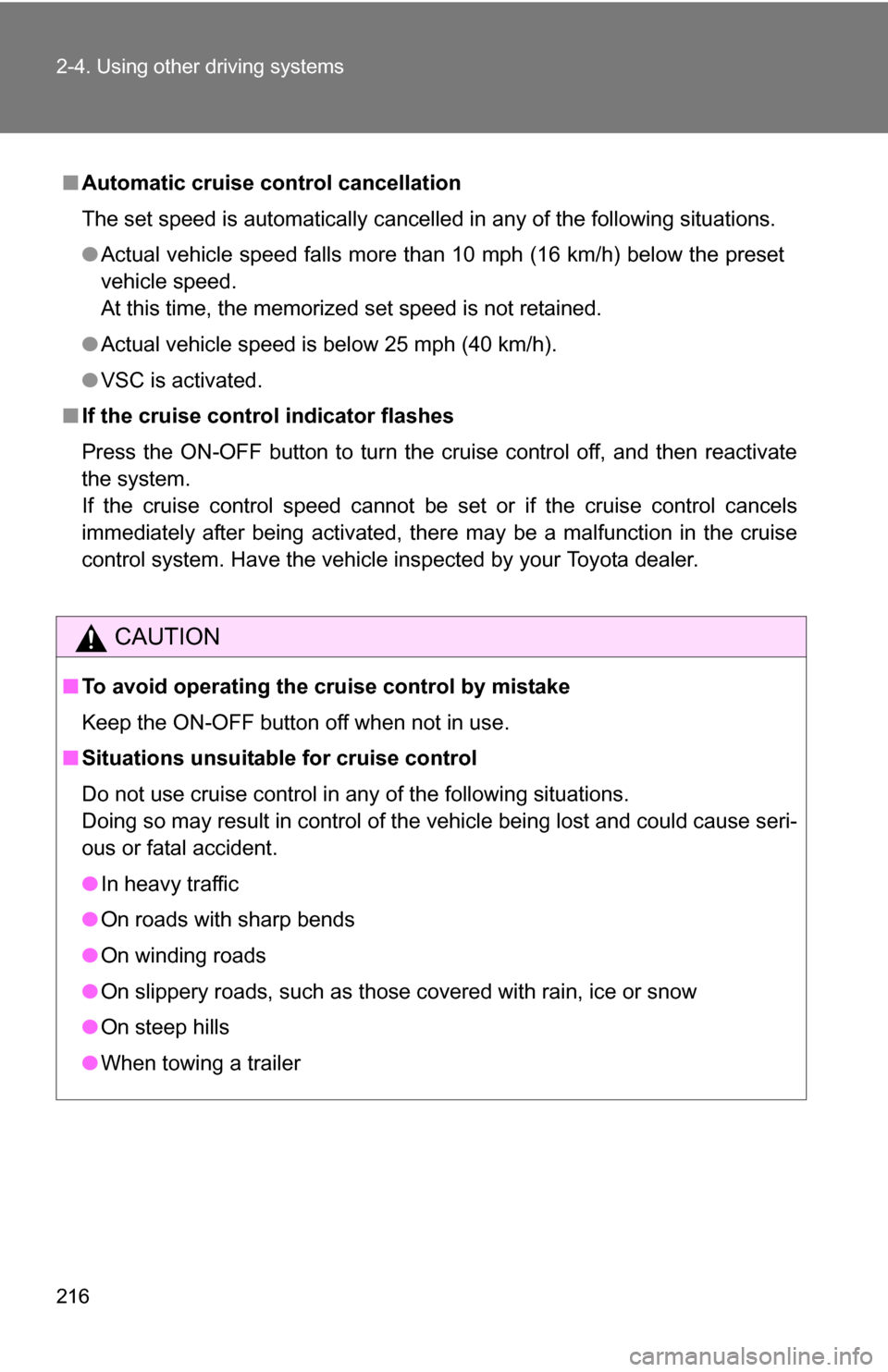
216 2-4. Using other driving systems
■Automatic cruise control cancellation
The set speed is automatically cancelled in any of the following situations.
●Actual vehicle speed falls more than 10 mph (16 km/h) below the preset
vehicle speed.
At this time, the memorized set speed is not retained.
● Actual vehicle speed is below 25 mph (40 km/h).
● VSC is activated.
■ If the cruise control indicator flashes
Press the ON-OFF button to turn the cruise control off, and then reactivate
the system.
If the cruise control speed cannot be set or if the cruise control cancels
immediately after being activated, there may be a malfunction in the cruise
control system. Have the vehicle inspected by your Toyota dealer.
CAUTION
■To avoid operating the cruise control by mistake
Keep the ON-OFF button off when not in use.
■ Situations unsuitable for cruise control
Do not use cruise control in any of the following situations.
Doing so may result in control of the vehicle being lost and could cause seri-
ous or fatal accident.
●In heavy traffic
● On roads with sharp bends
● On winding roads
● On slippery roads, such as those covered with rain, ice or snow
● On steep hills
● When towing a trailer
Page 217 of 672
217
2-4. Using other driving systems
2
When driving
Intuitive parking assist (if equipped)
The intuitive parking assist is designed to inform you of the approxi-
mate distance between your vehicle and an obstruction by indicator
and buzzer when parking the veh icle. This system uses sensors to
detect obstructions.
■ Sensor types
Back sensors
Rear corner sensors
Front corner sensors
■ Intuitive parking assist switch
Press the switch to turn on.
(To turn off, press the switch
again.)
When on, the buzzer sounds
to inform the driver that the
system is operational. At this
time, the indicator will come
on.
Page 218 of 672
218 2-4. Using other driving systems
The distance and buzzer■ When a sensor detects an obstacle.
The buzzer sounds.
Back sensors
Rear corner sensors
Zone
Distance
shown as
in in. (mm)Indicator
and buzzer
Far
Approximately
70.9—45.3
(1800—1150)
Intermittent
Mid
Approximately
45.3—33.5
(1150—850)Fast
intermittent
Near
Approximately
33.5 (850) or
less
Continuous
Zone
Distance
shown as
in in. (mm)Indicator
and buzzer
Far
Approximately
33.5—20.5
(850—520)
Intermittent
Mid
Approximately
20.5—15.7
(520—400)Fast
intermittent
Near
Approximately
15.7 (400) or
less
Continuous
Page 219 of 672
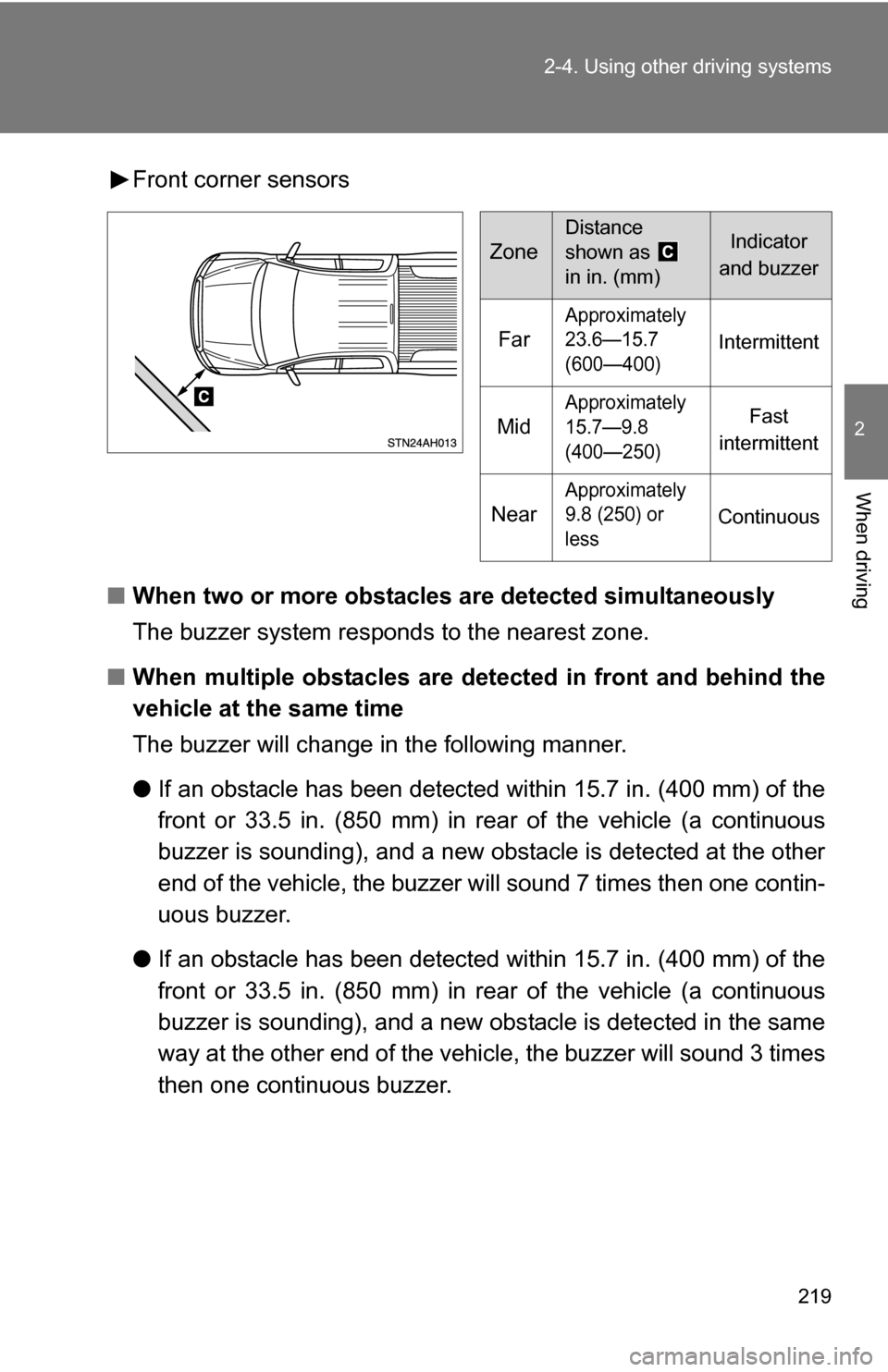
219
2-4. Using other
driving systems
2
When driving
Front corner sensors
■ When two or more obstacles are detected simultaneously
The buzzer system responds to the nearest zone.
■ When multiple obstacles are detected in front and behind the
vehicle at the same time
The buzzer will change in the following manner.
● If an obstacle has been detected within 15.7 in. (400 mm) of the
front or 33.5 in. (850 mm) in rear of the vehicle (a continuous
buzzer is sounding), and a new obstacle is detected at the other
end of the vehicle, the buzzer will sound 7 times then one contin-
uous buzzer.
● If an obstacle has been detected within 15.7 in. (400 mm) of the
front or 33.5 in. (850 mm) in rear of the vehicle (a continuous
buzzer is sounding), and a new obs tacle is detected in the same
way at the other end of the vehi cle, the buzzer will sound 3 times
then one continuous buzzer.
Zone
Distance
shown as
in in. (mm)Indicator
and buzzer
Far
Approximately
23.6—15.7
(600—400)
Intermittent
Mid
Approximately
15.7—9.8
(400—250)Fast
intermittent
Near
Approximately
9.8 (250) or
less
Continuous
Page 220 of 672
220 2-4. Using other driving systems
Sensors that operate and detection rangeThe following diagrams show the sensor detection range. Note that
sensors may not be able to detect obstacles that are extremely close
to the vehicle.
■ Detection range of the sensors
Back sensors
Rear corner sensors
Front corner sensors
Perceptible area
Approx. 70.9 in. (1800 mm)
Approx. 33.5 in. (850 mm)
Approx. 23.6 in. (600 mm)
The diagram shows the detection range of the sensors. Note that the sen-
sors may not be able to detect obstacles that are extremely close to the vehi-
cle.
The range of the sensors may change depending on the shape of the object\
etc.
Trending: immobilizer, traction control, wiper fluid, maintenance, clock, remove seats, climate control
